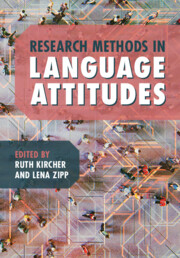Book contents
- Research Methods in Language Attitudes
- Research Methods in Language Attitudes
- Copyright page
- Contents
- Figures
- Tables
- Contributors
- Foreword
- Acknowledgements
- 1 An Introduction to Language Attitudes Research
- Part 1 Analysis of the Societal Treatment of Language
- Part 2 Direct Methods of Attitude Elicitation
- 7 Semi-Structured Interviews
- 8 Focus Groups
- 9 Questionnaires to Elicit Quantitative Data
- 10 Questionnaires to Elicit Qualitative Data
- 11 Perceptual Dialectology
- Part 3 Indirect Methods of Attitude Elicitation
- Part 4 Overarching Issues in Language Attitudes Research
- References
- Index
- References
10 - Questionnaires to Elicit Qualitative Data
from Part 2 - Direct Methods of Attitude Elicitation
Published online by Cambridge University Press: 25 June 2022
- Research Methods in Language Attitudes
- Research Methods in Language Attitudes
- Copyright page
- Contents
- Figures
- Tables
- Contributors
- Foreword
- Acknowledgements
- 1 An Introduction to Language Attitudes Research
- Part 1 Analysis of the Societal Treatment of Language
- Part 2 Direct Methods of Attitude Elicitation
- 7 Semi-Structured Interviews
- 8 Focus Groups
- 9 Questionnaires to Elicit Quantitative Data
- 10 Questionnaires to Elicit Qualitative Data
- 11 Perceptual Dialectology
- Part 3 Indirect Methods of Attitude Elicitation
- Part 4 Overarching Issues in Language Attitudes Research
- References
- Index
- References
Summary
Following on from the previous chapter on questionnaire-based elicitation of quantitative data, this chapter outlines how open-ended questionnaire items can be used to elicit qualitative language attitudes data. These items invite the respondent to freely answer a question with a few words, sentences, or a paragraph of free writing, thereby eliciting idiosyncratic responses. Open-ended items provide complex and potentially unexpected information on the different attitude components and can thus play a complementary role to closed-ended items in the evaluation of attitudes. The chapter guides the reader through a wide range of ways to use open-ended items and discusses their strengths as well as weaknesses. Building on the preceding chapter, key issues of study design are added, including the choice of open-ended question types and factors that inform decisions of participant sampling. The chapter instructs the reader how to pilot a questionnaire and how to conduct (inductive or deductive) qualitative content analysis. Finally, it addresses ethical concerns of privacy and confidentiality. A case study on attitudes towards different varieties of English in Fiji serves as illustration of the main points made in the chapter.
Keywords
- Type
- Chapter
- Information
- Research Methods in Language Attitudes , pp. 145 - 159Publisher: Cambridge University PressPrint publication year: 2022



